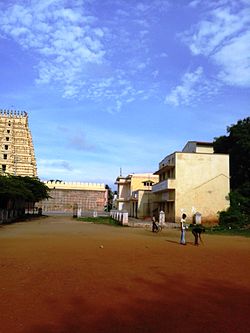Nagamangala
|
Nagamangala ನಾಗಮಂಗಲ |
|
|---|---|
| Town | |

Rotary School, Nagamangala
|
|
| Coordinates: 12°49′N 76°46′E / 12.82°N 76.76°ECoordinates: 12°49′N 76°46′E / 12.82°N 76.76°E | |
| Country |
|
| State | Karnataka |
| District | Mandya |
| Elevation | 772 m (2,533 ft) |
| Population (2011) | |
| • Total | 17,776 |
| Languages | |
| • Official | Kannada |
| Time zone | IST (UTC+5:30) |
| Vehicle registration | KA-54 |
| Website |
[<span%20class="url"> |
Nagamangala is a town panchayath in Mandya district in the Indian state of Karnataka.
As of 2011[update] India census, Nagamangala had a population of 17776. Males constitute 50% of the population and females 50%. Nagamangala has an average literacy rate of 87.01%, higher than the state average of 75.36%: male literacy is 90.16%, and female literacy is 83.98%. In Nagamangala, 12% of the population is under 6 years of age.
The quiet town of Nagamangala is also known for its temples. The ones which attract the tourists are the Saumyakeshava temple and the Yoganarasimha temple which are located one behind the other. There's also a Jain temple, the Panchakuta Basadi which has a group of seven shrines that are considered the oldest Jain monuments of the State. There are also numerous other famous temple like Veerabhadreshwara. There is a Brahmakumaris temples on old post office road behind the Soumya Keshava temple.
Sauymakesava Temple, Nagamangala was constructed in the 12th century by the rulers of the Hoysala empire. Nagamangala is a town in the Mandya district of Karnataka state, India. It is located 62 km from the historically important town Mysore, on the Srirangapatna-Jeevargi National highway. Historically, Nagamangala came into prominence during the rule of Hoysala King Vishnuvardhana when it became an important center of Vaishnava faith and received patronage from one of his queens, Bommaladevi. During the rule of Veera Ballala II, Nagamangala prospered as an agrahara (place of Hindu religious studies) and had the honorific Vira Ballala Chaturvedi Bhattaratnakara. The temple is protected as a monument of national importance by the Archaeological Survey of India. According to art historian Adam Hardy, the basic plan of the shrine (mulaprasada) is stellate (star shaped). It stands on a platform called jagati and is constructed with Soap stone material. According to historian Percy Brown this is a Hoysala innovation. Overall, the temple exhibits the nagara features (northern Indian influence) seen in a few other Hoysala temples such as in the Sadasiva Temple, Nuggehalli. According to art historians Gerard Foekema and Percy Brown, nagara features are seldom seen in Hoysala temples.The temple is a large structure and has received patronage by multiple dynasties and reveals features of the later day Vijayanagara empire whose rulers added the entrance and tower over it (mahadvara) and bounding walls (prakara). Some post-Vijayanagara features are also visible. The tower over the entrance (gopuram) is a 7-story tall lime and brick structure that is adorned by Hindu gods, goddesses and other decorative structures in stucco. The temple is three shrined
...
Wikipedia
